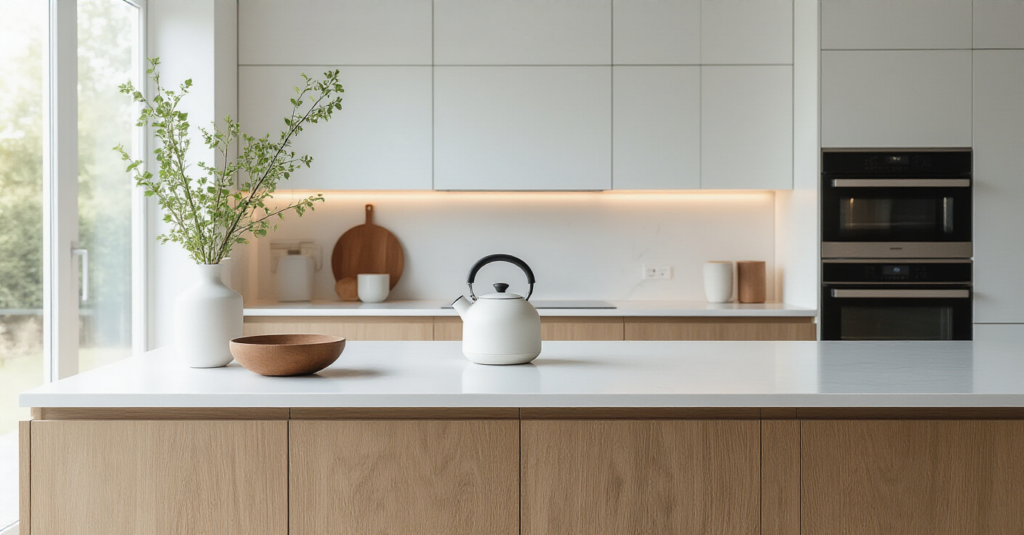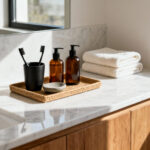You know what people always ask me? They have a beautiful old house—a Tudor, a Craftsman, maybe a Victorian—and they want a new kitchen. But they’re terrified. They see all these ultra-modern, glossy white boxes online and think, “Is that going to look ridiculous in my home? Is it going to look dated in five years?” It’s a great question, because they’re confusing “modern” with “trendy.”
Trendy is the fleeting stuff—the chevron-patterned backsplash that everyone had in 2015. Modern, when it’s done right, isn’t a style as much as a philosophy: clean lines, honest materials, and ruthless functionality. It’s about stripping away the noise to let quality and purpose shine through. It’s the same principle that makes a 100-year-old piece of solid-wood furniture feel more timeless than a particleboard cabinet from last season. So let’s talk about how to get that timeless modern feel without turning your kitchen into a sterile laboratory.
Foundational Principles: Establishing the Modern Vibe
Before you even think about cabinet colors or countertop materials, you have to get the philosophy right. This is the foundation. Mess this up, and the whole thing will feel off, no matter how much you spend on appliances. This is about setting a calm, cohesive stage for everything else.
1. Embrace Minimalism for a Clutter-Free Space
Can we talk about why everyone gets this wrong? Minimalism isn’t about owning three forks and sitting on the floor. In a kitchen, it’s about making sure every single thing has a purpose and a place. It’s about curating your tools so the space can breathe. I’ve seen hundred-year-old homes with tiny, quirky kitchens that feel absolutely massive after a minimalist overhaul, not because we blew out walls, but because we got rid of the visual noise.
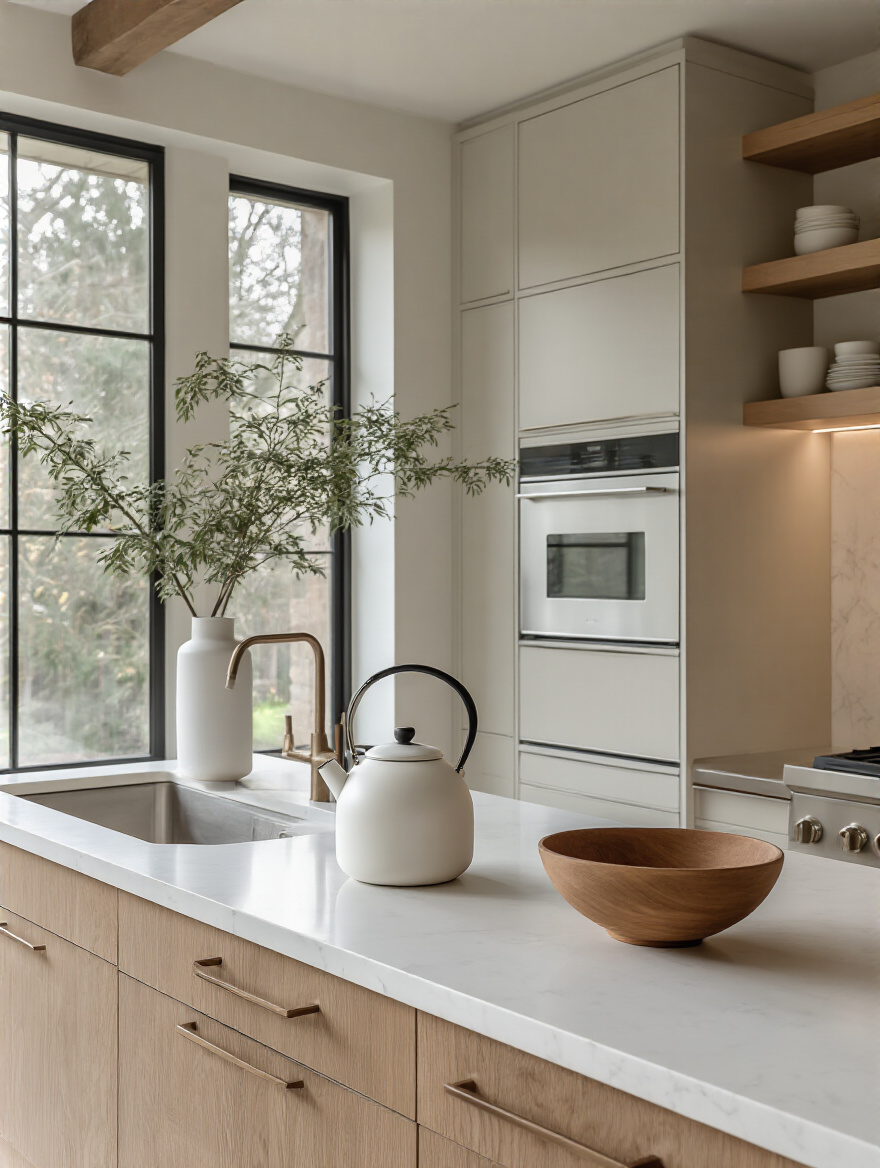
Most of what people call clutter is just a series of postponed decisions. The real work happens before you even call a contractor. You have to be ruthless. Pull everything out. If you haven’t used that quesadilla maker in two years, it’s a guest in your house that has overstayed its welcome. The goal isn’t to be stark; it’s to create a calm, functional workspace. Once you know what you actually need to store, designing the kitchen becomes ten times easier.
The best shortcut I know is this: design your storage for the 80% of things you use all the time, and find a secondary, less convenient spot for the other 20% (the Thanksgiving turkey platter, the giant punch bowl). This keeps your prime real estate free and your counters clear, which is the entire point.
2. Select a Cohesive Neutral Color Palette
People hear “neutral” and they immediately think “boring.” They picture endless seas of beige. That’s a total misunderstanding of the concept. A neutral palette doesn’t mean a lack of color; it means creating a quiet, sophisticated backdrop that lets other things become the star of the show. Think of it as the gallery wall, not the painting.
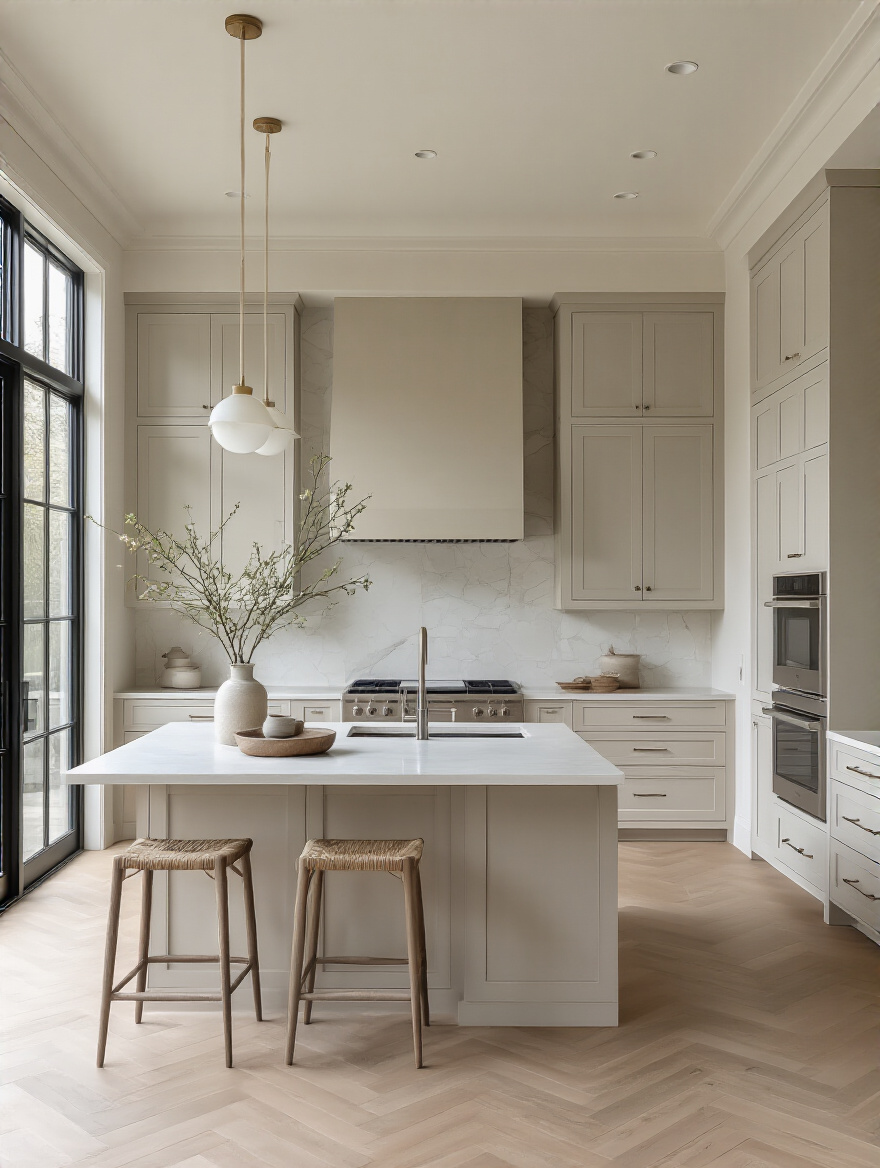
In an old house, the “star” might be an original leaded glass window, a beautiful archway, or the view into a garden. Your calm, neutral kitchen shouldn’t compete with that—it should complement it. Warm whites, soft grays, and deep charcoals add depth and sophistication without screaming for attention. The real BS is when people think they need a loud “accent wall” in the kitchen. No, you don’t. Your accent is the beautiful slab of stone you chose for the island or the incredible copper pots you’ve had for twenty years.
A quick tip: get paint swatches, but don’t just stick them on the wall. Paint a large piece of foam board and move it around the room throughout the day. The way natural light hits in an old house can have weird undertones. That perfect “greige” in the morning might look sickly green by the afternoon. Live with it before you commit.
3. Maximize Natural Light for Openness and Brightness
I used to think opening up a space was all about taking down walls. Then I worked on a 1920s brick Tudor with a north-facing kitchen that was as dark as a cave. The clients thought they needed a huge addition. Instead, we simply replaced a small, high window over the sink with a much larger one and added a glass door to the garden. It completely transformed the space for a fraction of the cost.
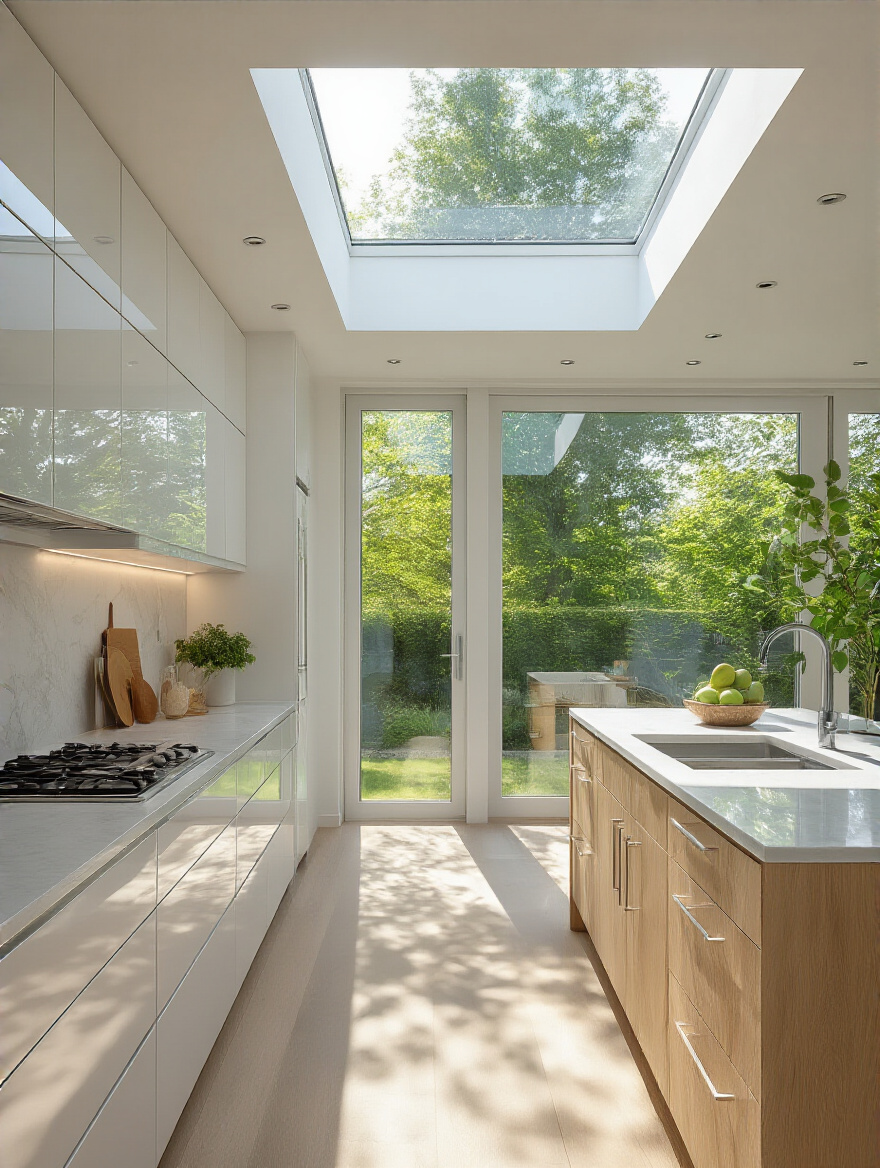
Older homes were often built with smaller windows to conserve heat. We don’t have that problem anymore. Honoring the architecture doesn’t mean you have to live in the dark. Light is the cheapest, most effective way to make any space feel bigger, cleaner, and more welcoming. Look for any opportunity to let more in. Can a window be taller or wider? Can you add a skylight?
The biggest mistake I see is people spending a fortune on a remodel and then blocking their brand-new window with a clunky cabinet or a refrigerator. Plan your layout around your light sources first. Let the light dictate where everything else goes. It’s the most powerful tool you have.
4. Prioritize Quality, Durable Materials for Longevity
This is my soapbox moment. We live in a world of disposable junk. But the whole point of a good renovation, especially in a home with history, is to build something that lasts. I have seen original, 100-year-old oak cabinets that are in better structural shape than 10-year-old particleboard boxes held together with glue and hope. The “modern” aesthetic crumbles when it’s built from cheap materials.
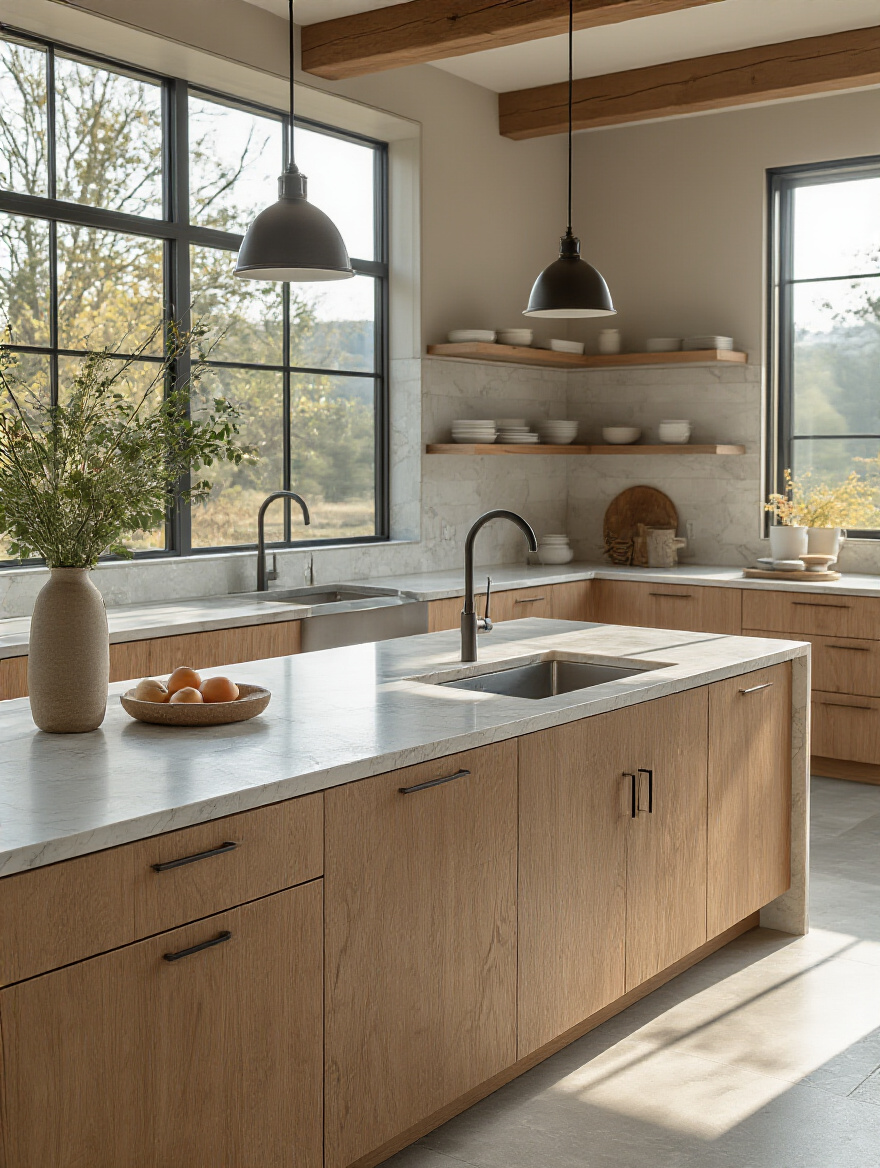
Stop looking at the initial price tag and start thinking about the “cost per year.” That quartz countertop might cost 30% more than the cheap laminate, but if it lasts 30 years instead of 10, what was actually the better deal? Quality isn’t just about looks; it’s about how things feel. It’s the satisfying heft of a solid drawer, the cool, smooth surface of real stone, the silence of a soft-close hinge. These are the things that make a kitchen a joy to use every single day.
Don’t let anyone sell you on thermofoil or cheap laminates for a high-use kitchen. They will peel, they will chip, and you will hate them in three years. My shortcut here is to put your money where the wear is: countertops, cabinet fronts, flooring, and faucets. You can save money on things like drawer organizers or backsplash tile, but never skimp on the surfaces you touch and use every day.
5. Define Your Unique Modern Kitchen Style Nuance
Okay, so you want “modern.” But what does that even mean? A modern kitchen in a sleek Miami condo should feel totally different from a modern kitchen in a Vermont farmhouse. Don’t just walk into a showroom and say, “I’ll take that one.” That’s how you get a kitchen with no soul. Your home’s architecture should be your guide.
Are you in a Craftsman? Maybe your “modern” includes the clean lines of slab-front cabinets, but they’re made of a warm, rift-sawn white oak to echo the home’s original woodwork. Is it a mid-century modern ranch? Then lean into those sleek lines with some pops of color and maybe a beautiful walnut veneer. The idea is to create a dialogue between the old and the new, not a shouting match.
I learned this the hard way years ago. A client insisted on a hyper-glossy, all-white European-style kitchen for their cozy 1930s bungalow. It was beautifully made, but it felt like a spaceship had landed in the middle of the house. It was completely alien. The best modern kitchens feel like a natural evolution of the home’s original character, not an erasure of it.
6. Ensure Seamless Transitions Between Spaces
Everyone says “open concept,” but they often do it wrong, especially in older homes where rooms had distinct purposes. Simply sledgehammering every wall isn’t design; it’s demolition. The goal of a “seamless transition” isn’t to make your entire first floor one giant room, but to create a graceful and logical flow between the kitchen and the spaces around it.
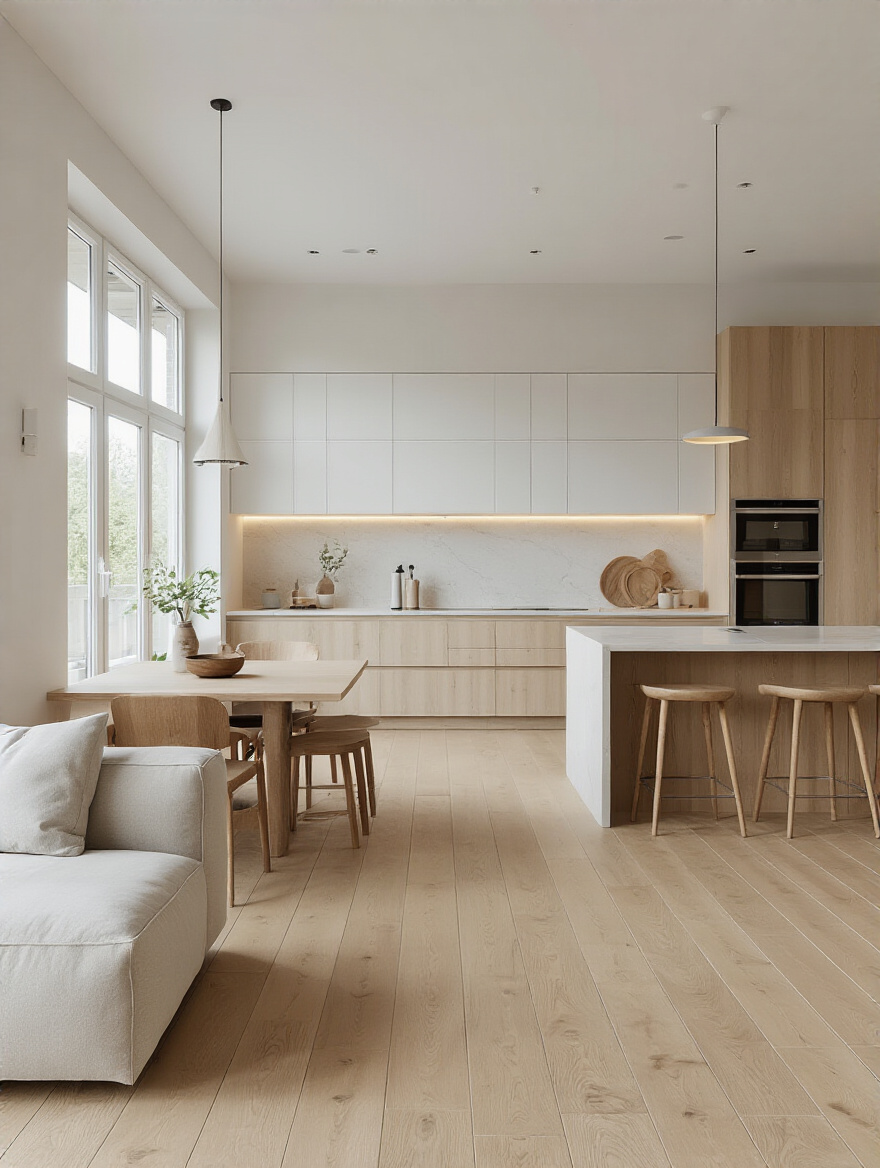
The best way to do this is with consistent flooring. Running the same material—be it wood or large-format tile—from the kitchen into the dining or living area is the single most effective trick for making a space feel larger and more cohesive. It erases the awkward threshold and lets the eye travel without interruption. When you change flooring, you’re basically drawing a line on the floor and telling people, “The kitchen stops here.”
A common pitfall is creating an opening that’s too big, leaving you with no usable walls. In one project, we chose to widen a doorway from three feet to six feet instead of removing the whole wall. It created a beautiful connection to the dining room while still giving both rooms a sense of definition and walls for furniture or art. Don’t assume total openness is the only answer.
Architectural Elements: Structuring Your Modern Kitchen
Now we get to the bones. These are the big, physical choices that will define the look and feel of your kitchen. Get these right, and the details will fall into place much more easily.
7. Choose Slab Doors for Sleek Cabinet Profiles
If you want the quickest way to signal “modern,” this is it. A slab door is just a flat panel. No fussy details, no grooves, no shaker-style frames. It’s clean, simple, and honest. Its beauty comes from its simplicity and the quality of the material itself, whether that’s a beautiful wood grain, a super-matte laminate, or a flawless coat of lacquer.
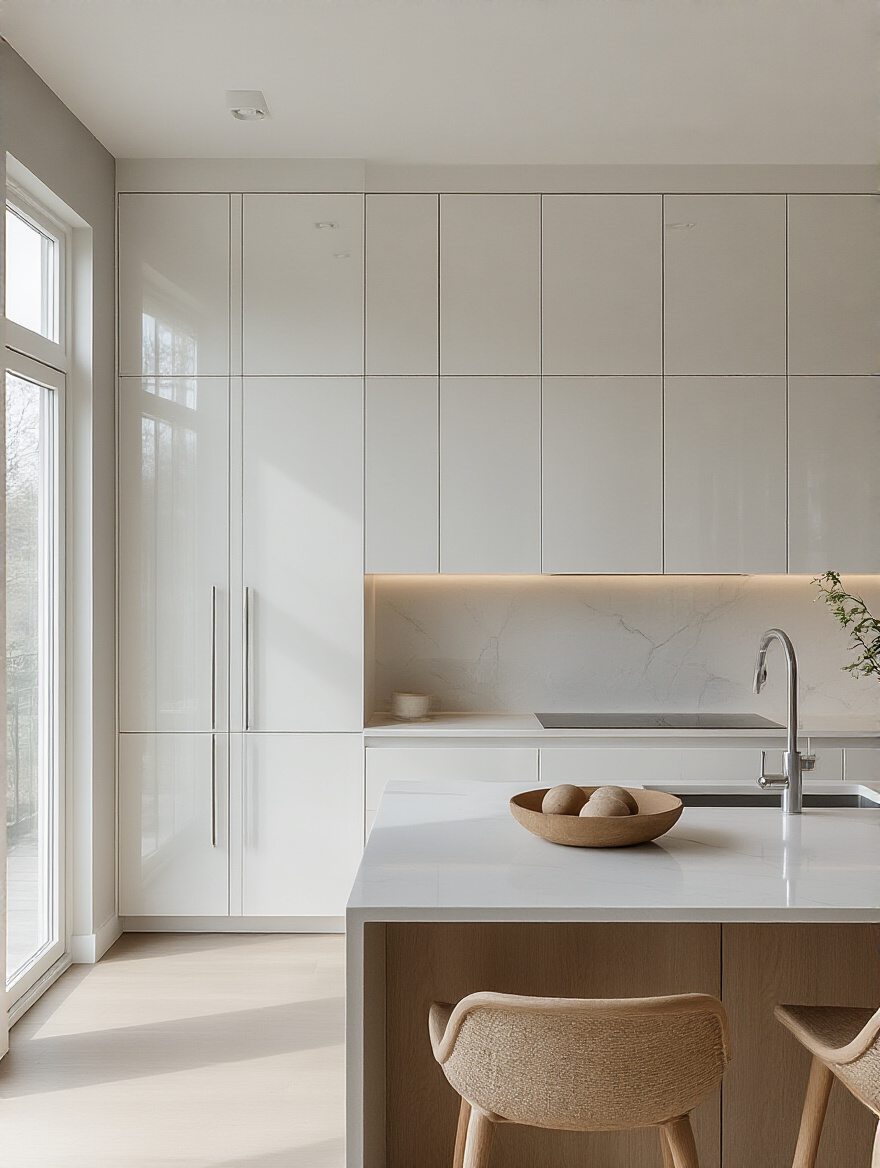
Because they are so simple, the quality has to be perfect. Any imperfection, any slight misalignment, will stick out like a sore thumb. This is not a place to skimp on installation. Make sure your installer knows how to get perfect, consistent gaps.
My personal take? I love a rift-sawn white oak or walnut veneer for slab doors in an older home. It brings in so much natural warmth and texture, acting as a bridge between the historical character of the house and the clean lines of the modern design. It’s the best of both worlds.
8. Integrate Handleless Cabinetry for a Clean Look
This takes the sleekness of slab doors one step further. By getting rid of the hardware, you create long, uninterrupted visual lines that can make a kitchen feel incredibly serene and spacious. There are a few ways to do this, and everyone seems to have an opinion, but they boil down to two main camps.
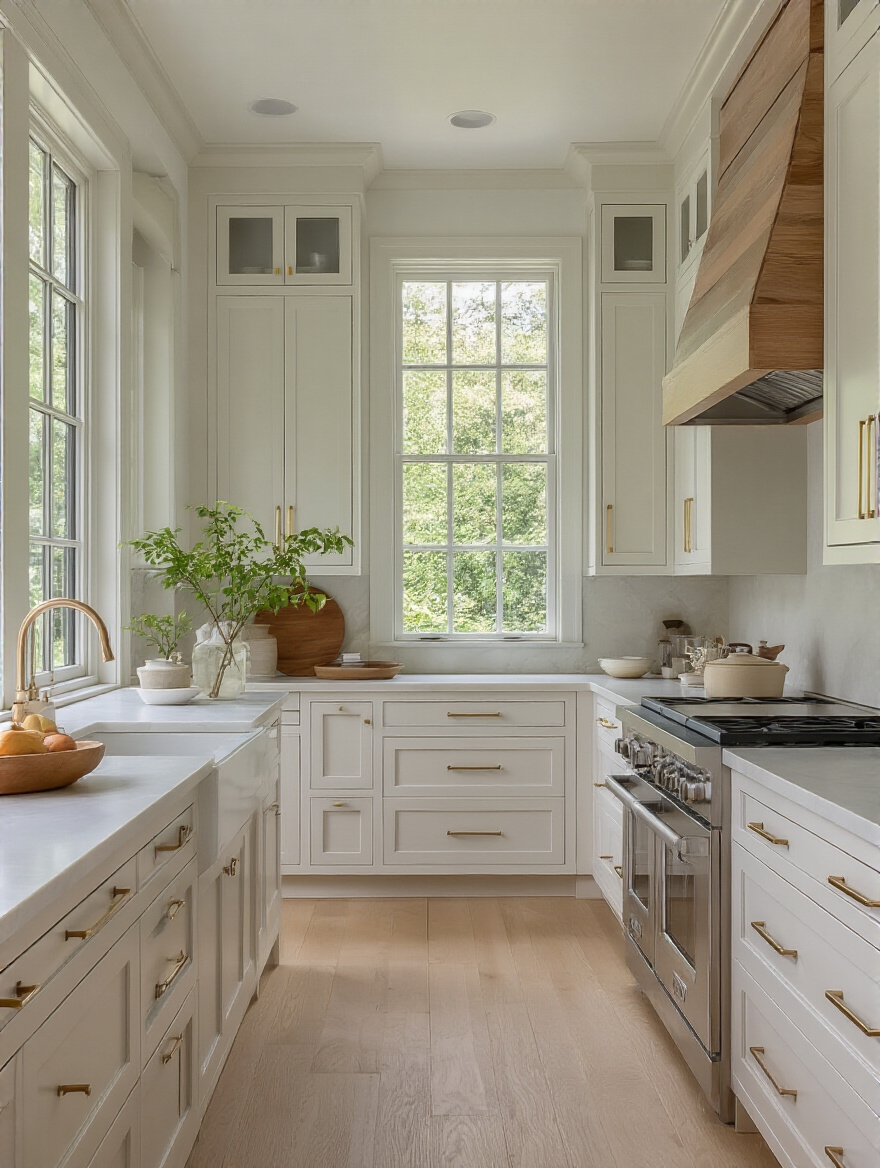
First, you have integrated channels or “J-pulls,” where a groove is routed into the top or side of the door for your fingers. This is my preferred method. It’s intuitive, reliable, and doesn’t require any mechanisms. The other option is “push-to-open” hardware. It looks incredibly cool and is perfect for upper cabinets you don’t use constantly. But I’ll confess: I had a client install them on every single cabinet, including their trash pull-out. They were constantly bumping into it with their hip and popping it open by accident. For high-traffic doors and drawers, a subtle integrated pull is often more practical.
Don’t fall for the BS that you need one system for the whole kitchen. A mix-and-match approach is often the smartest. Use push-to-open for those high, clean-looking cabinets and a comfortable J-pull for everything below the counter. Function first, always.
9. Design a Multipurpose Island as a Central Hub
The kitchen island has become the new family hearth. It’s where homework gets done, where friends gather with a glass of wine, where you chop vegetables and serve a buffet. But a lot of them are poorly designed—they’re just giant, generic blocks in the middle of the room. A great island has distinct zones for different tasks.
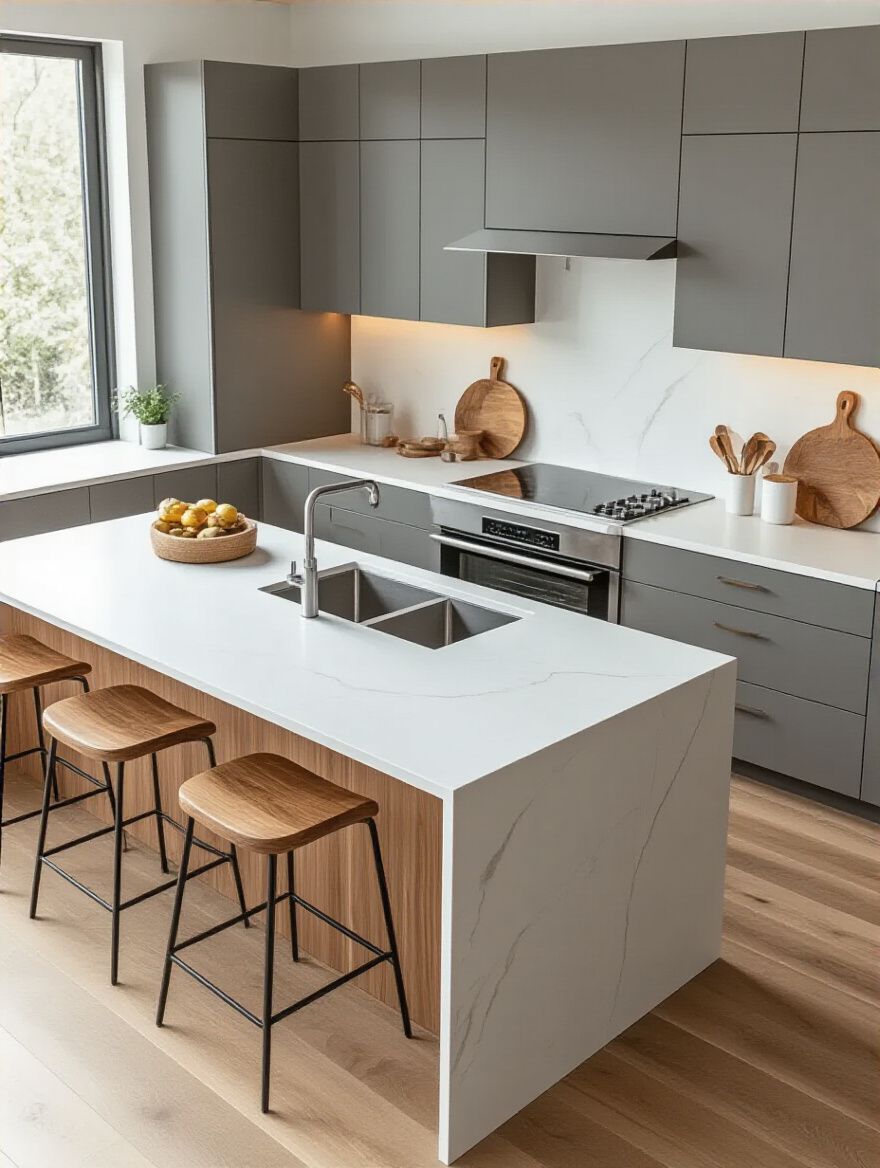
Don’t just make it one big flat surface. Think about varying the heights or materials to define function. Maybe the prep area is a durable quartz, while the seating area steps down a few inches and is a warmer butcher block. I once designed an island with a built-in trough in the middle. The owner could fill it with ice for drinks when entertaining, or use it as a planter for fresh herbs day-to-day. It was a functional, beautiful centerpiece.
The shortcut here is to plan your island’s function before you plan its shape. Do you need a prep sink? A cooktop? Outlets for laptops? Storage for cookbooks? Answer those questions, and the right design will start to emerge. And please, for the love of all that is holy, leave at least 42 inches of walkway around it. Anything less and it becomes an obstacle, not a hub.
10. Opt for Hidden or Integrated Appliances Seamlessly
This is one of the most powerful tools for blending a modern kitchen into a historic home. By facing your refrigerator and dishwasher with panels that match your cabinets, you make them disappear. The space stops looking like a machine for cooking and starts looking like a beautiful piece of custom furniture. It’s a game-changer for maintaining a calm, uncluttered aesthetic.
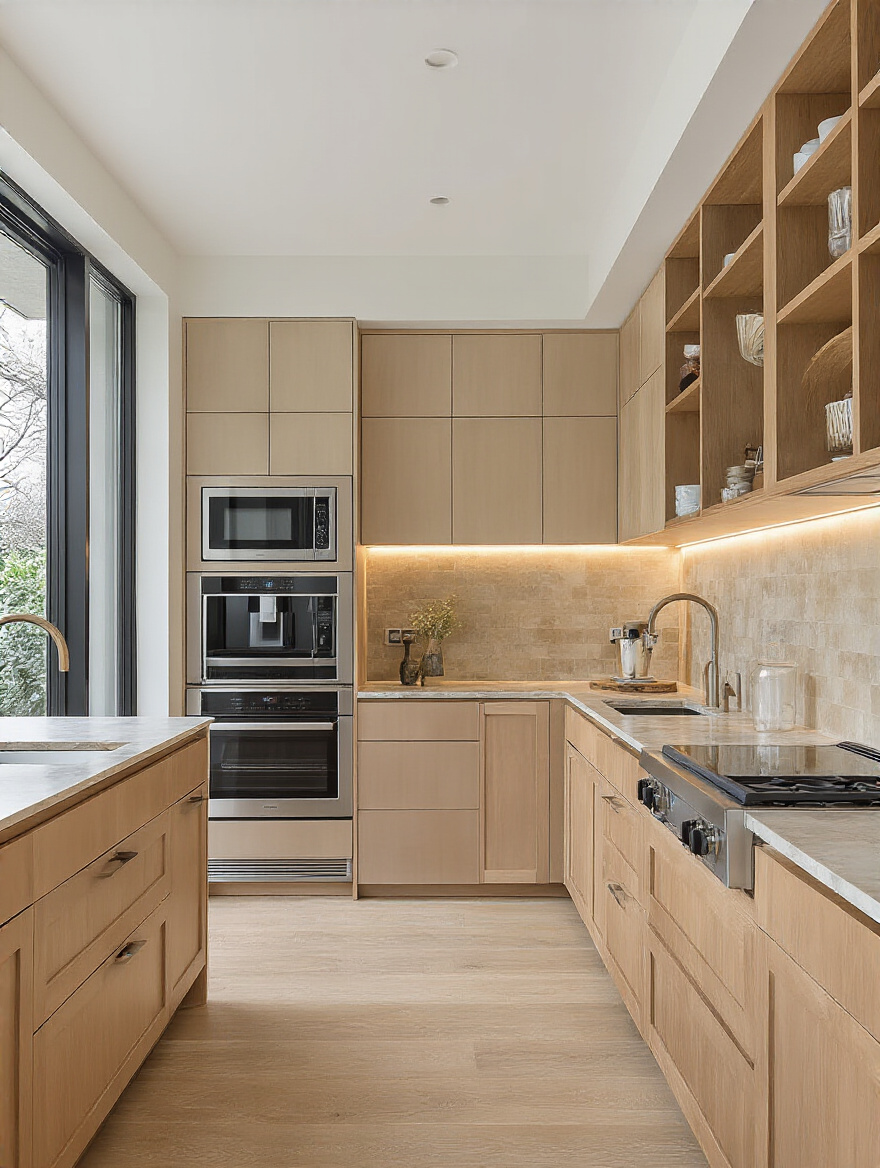
Yes, panel-ready appliances are more expensive. But they allow the craftsmanship of your cabinetry to be the star. The alternative is a big slab of stainless steel that breaks up the flow. When I’m working in a particularly beautiful historic home, this is one of the first things I recommend. It lets the kitchen’s architecture speak for itself.
One thing people often forget is ventilation. You can’t just slap a panel on any old appliance and stick it in a tight cabinet. They need to breathe. Make sure you’re buying appliances specifically designed to be integrated and that your cabinet maker follows the manufacturer’s specs to the letter. Otherwise, you’re just building a very expensive hotbox that will kill your appliances.
11. Select Low-Profile Sinks for Uninterrupted Countertops
This might seem like a small detail, but it has a huge impact on both looks and function. A low-profile or undermount sink sits below the level of the countertop. Why does this matter? Because it creates a smooth, continuous surface. You can wipe crumbs and spills directly from the counter into the sink with one motion. No gunk-collecting rim to worry about.
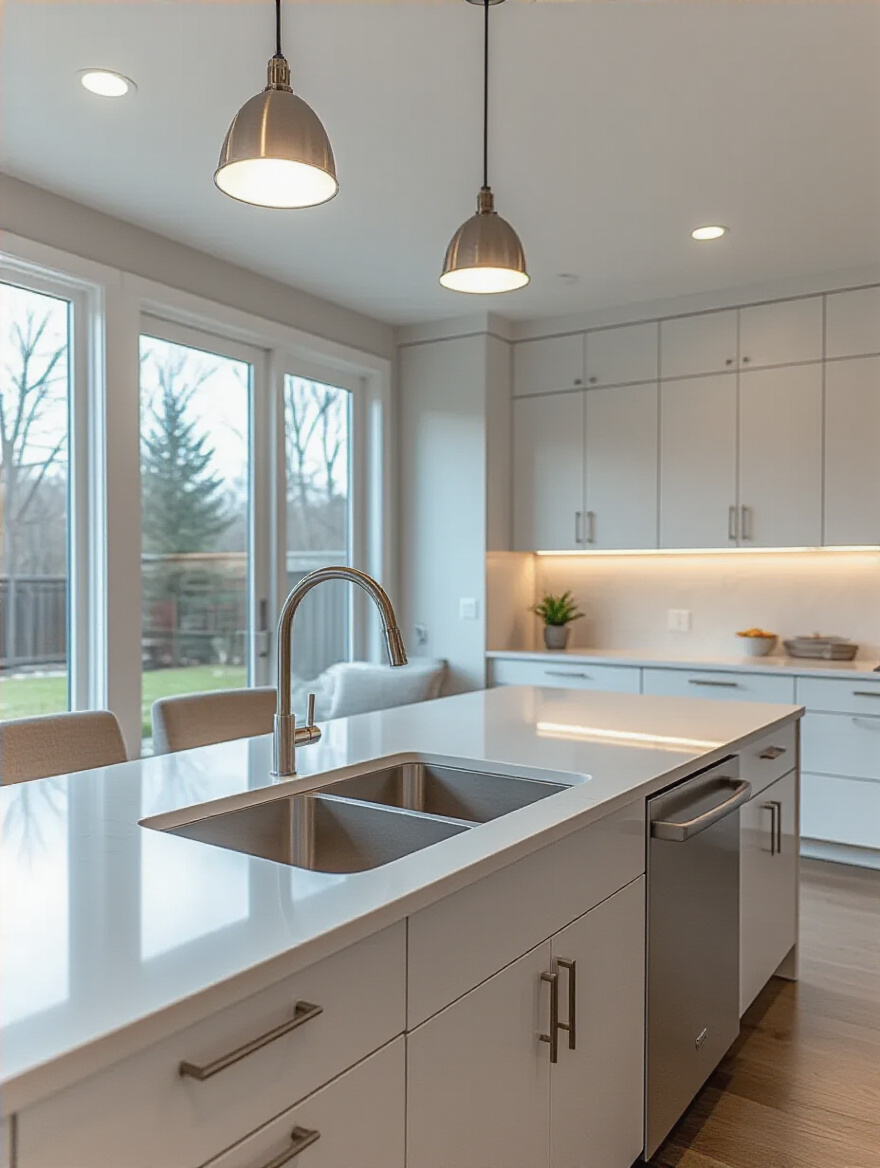
It’s one of those modern conveniences that, once you have it, you can’t imagine living without. It makes cleanup faster and the whole countertop area look sleeker and more expansive. Top-mount, or “drop-in,” sinks just visually chop up your work surface for no good reason.
The only caveat is your countertop material. You can’t do an undermount sink with a standard laminate countertop, as the exposed particleboard edge will be destroyed by water. This is a design choice that requires a solid surface like stone, quartz, or concrete. It’s a small detail that points to a higher overall quality of the build.
12. Specify Reflective or Matte Finishes for Countertops
Here’s the real story on countertop finishes. A polished, reflective surface (like you see on most granite and quartz) will bounce light around, which can help make a small or dark kitchen feel brighter. It has a certain drama and glamour to it. The downside? It shows every single fingerprint, water spot, and smudge. It’s a high-maintenance relationship.
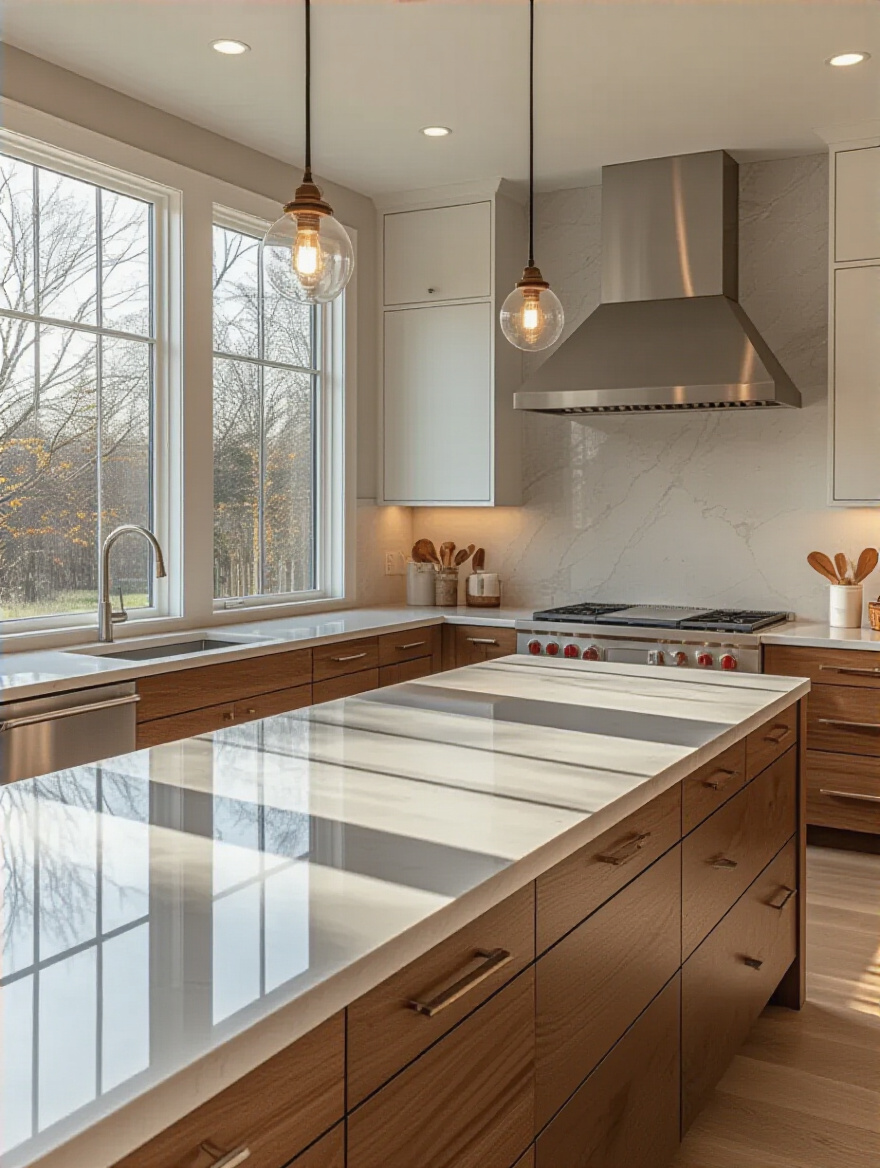
A matte or honed finish, on the other hand, absorbs light. It has a softer, more subtle, and very sophisticated feel. It’s incredibly good at hiding smudges and minor imperfections, making it a much more forgiving surface for a busy family kitchen. I find that matte finishes often let the natural texture and pattern of the material come through more honestly.
I used to think polished was the default. Then I put a honed marble countertop in a project, and the client was ecstatic. It had all the beauty of marble without the constant glare and smudging. My advice is to always get a large sample of both finishes. Take them home, put them on your counter, spill some stuff on them, and see which one you can actually live with.
Finishing Touches: Elevating Detail & Texture
You’ve got the foundation and the structure. Now comes the fun part. These are the details that infuse your kitchen with personality and keep it from feeling cold or one-note. This is where you transform a functional space into an exceptional one.
13. Install Layered Lighting for Ambiance and Function
Can we talk about my biggest pet peeve? It’s what I call the “interrogation room” kitchen. One giant, blazing light fixture in the middle of the ceiling that casts harsh shadows everywhere. It’s the worst. Good lighting in a kitchen is everything, and it needs to come in layers.
You need three kinds:
- Ambient: This is your overall, general light. Recessed cans are great for this. They provide a clean, even glow without being visually obtrusive.
- Task: This is focused light exactly where you need it for work—under your upper cabinets to light the counters, and pendants over the island. This is non-negotiable. It’s a safety and sanity issue.
- Accent: This is the “mood” lighting. Maybe it’s a light inside a glass-front cabinet to show off your beautiful dishes, or a low-level strip light at the toe-kick for a soft glow at night.
And here’s the shortcut you’ll thank me for later: put every single layer on a separate dimmer switch. This gives you complete control. You can have it bright as day when you’re cooking, or dim it all down for a cozy, atmospheric vibe when you have guests over. It’s the single most impactful finishing touch you can make.
14. Select Statement Faucets with Architectural Flair
In a minimalist kitchen where the surfaces are clean and simple, the faucet is like a piece of sculpture. It’s one of the few places where you can add a bit of drama and personality without creating clutter. It’s the jewelry of the sink area.
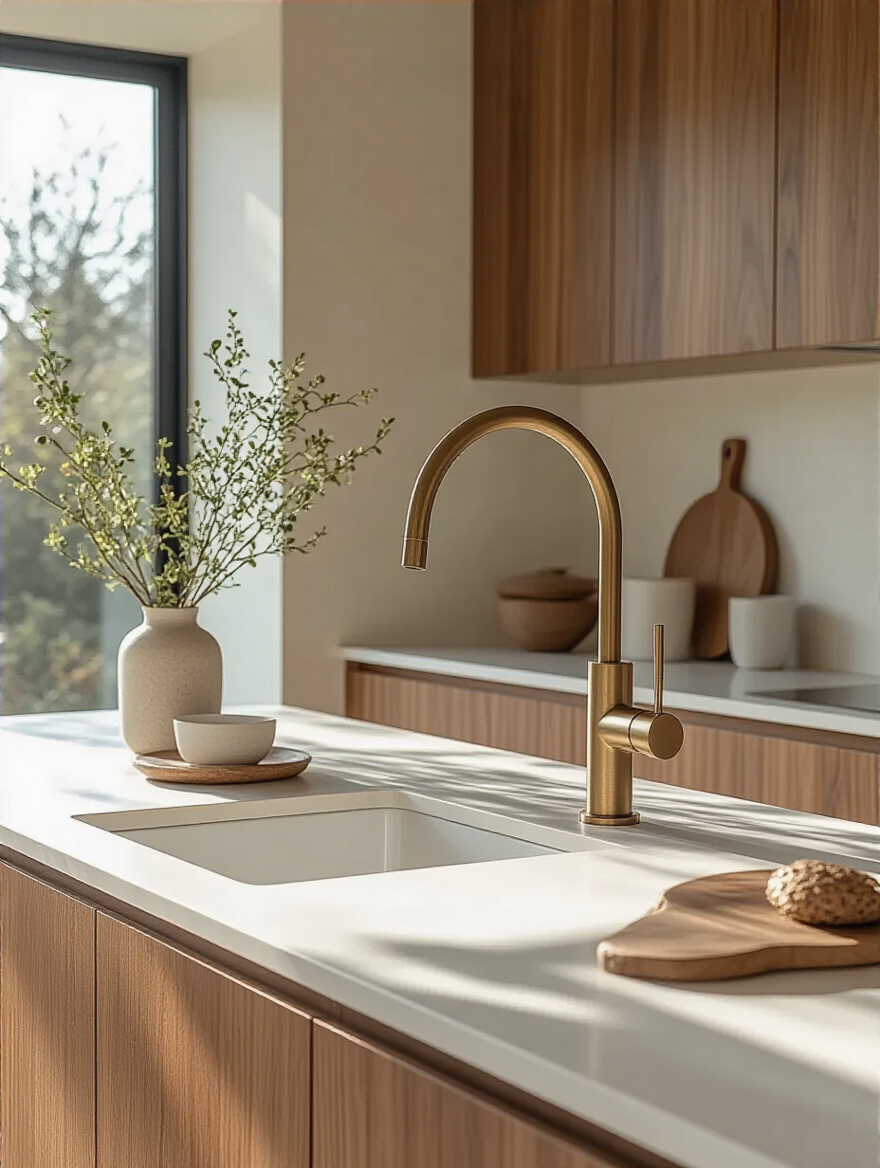
Don’t just pick the default chrome option from the big box store. Think about form and finish. A tall, gooseneck faucet in a matte black or brushed gold can become an incredible focal point. A sleek, minimalist design from a brand like Vola or Brizo can feel like a piece of modern art. It’s a place where spending a little extra money pays off in a big way every time you use it.
Just be sure to consider the scale. A massive, industrial-looking faucet might look amazing with a huge farmhouse sink, but it will completely overwhelm a smaller prep sink on an island. Form is important, but function and proportion are king.
15. Integrate Thoughtful Open Shelving for Display
Everyone says they want open shelving, but here’s the unvarnished truth: it’s not for your mismatched mugs and plastic Tupperware. Open shelving is a stage. It’s for displaying a small, curated collection of beautiful and frequently used items—your favorite ceramic bowls, a stack of white plates, some nice glassware.
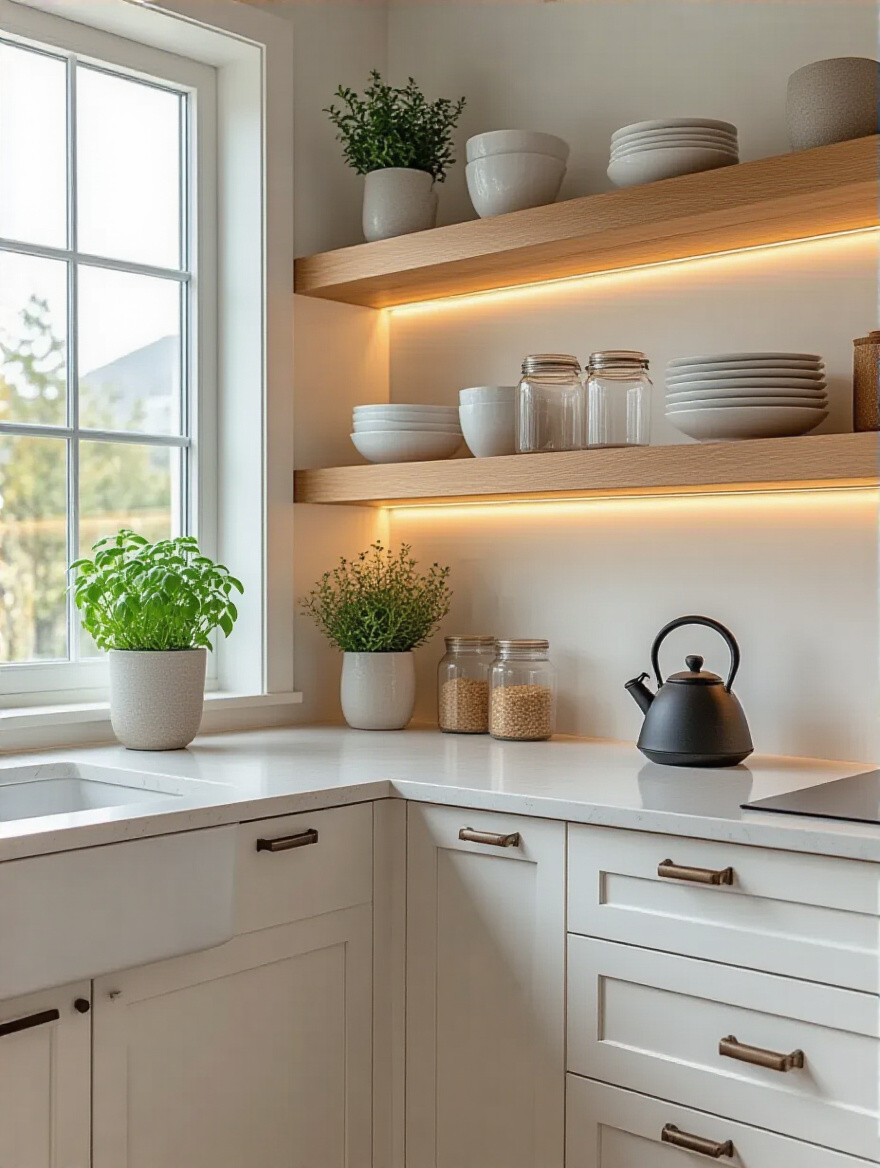
I love using a small section of open shelving to break up a long run of closed upper cabinets. It adds a sense of lightness and provides a spot to inject a little personality. In an old house, a shelf made from reclaimed wood from another part of the home can be a beautiful way to tie the new kitchen back to its history.
My advice is to be honest with yourself. Are you a tidy person? If the thought of constantly styling and dusting a shelf gives you anxiety, then this trend is not for you. And that’s okay. Glass-front cabinets can give you a similar light feeling with a lot less pressure to be perfect.
16. Choose Large-Format Tiles for Seamless Flooring
This is a simple trick with a huge visual payoff. Using large tiles—think 24×24 inches or even larger rectangular planks—dramatically reduces the number of grout lines on your floor. Fewer lines means less visual clutter, which makes the floor feel like a single, continuous surface. This, in turn, makes the entire room feel bigger and more serene.
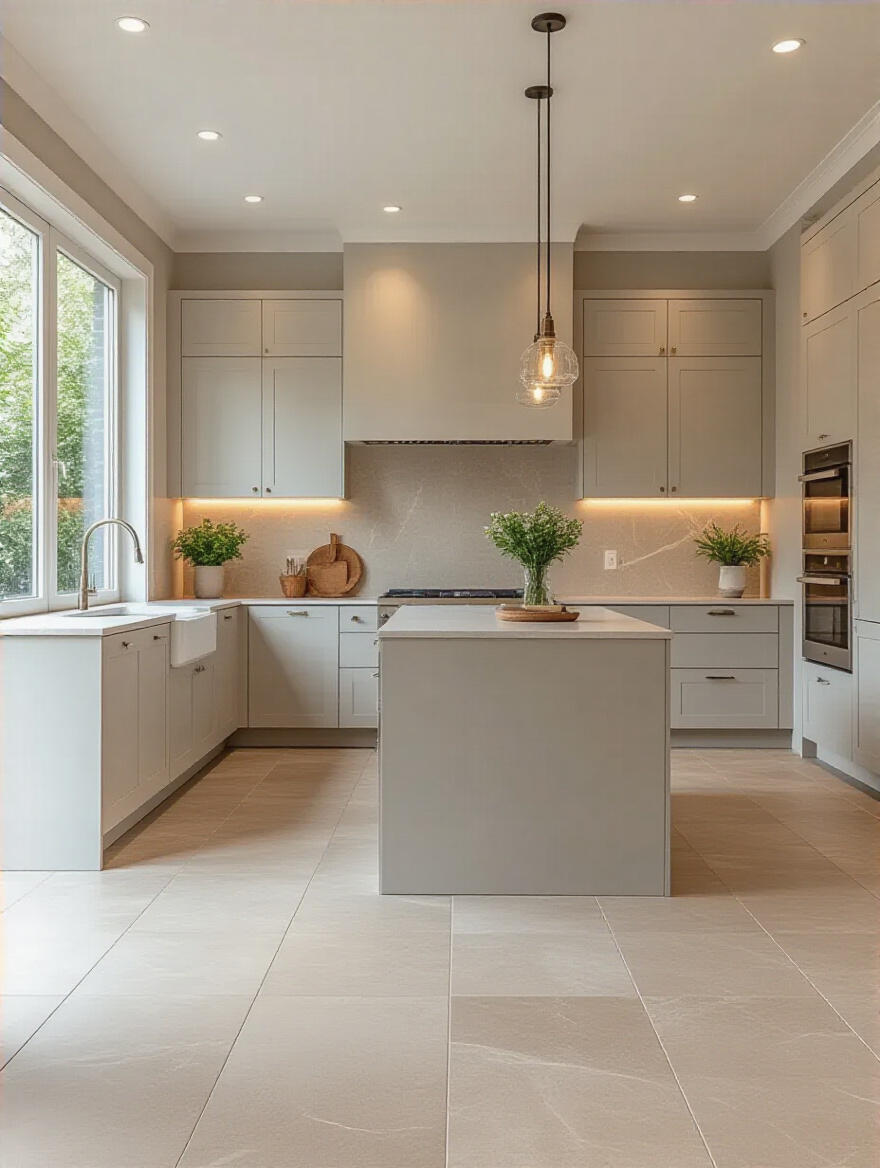
It’s a subtle but powerful effect. Your brain isn’t busy processing a grid pattern, so the space feels more expansive and calm. It works beautifully in both large, open-plan spaces and smaller, more constrained kitchens where you want to maximize the sense of space.
A word of warning: large tiles are unforgiving. Your subfloor has to be perfectly flat and level, and you need an installer who really knows what they’re doing. Any little imperfection will be magnified. Don’t try to save a few bucks on installation here; it’s a recipe for cracked tiles and lippage down the road.
17. Add Subtle Biophilic Elements for Natural Warmth
Okay, “biophilic elements” is just a fancy way of saying “bring some nature inside.” It’s incredibly important in a modern kitchen, which can sometimes lean a little cold or sterile with all its hard surfaces and clean lines. You need to add life. Literally.
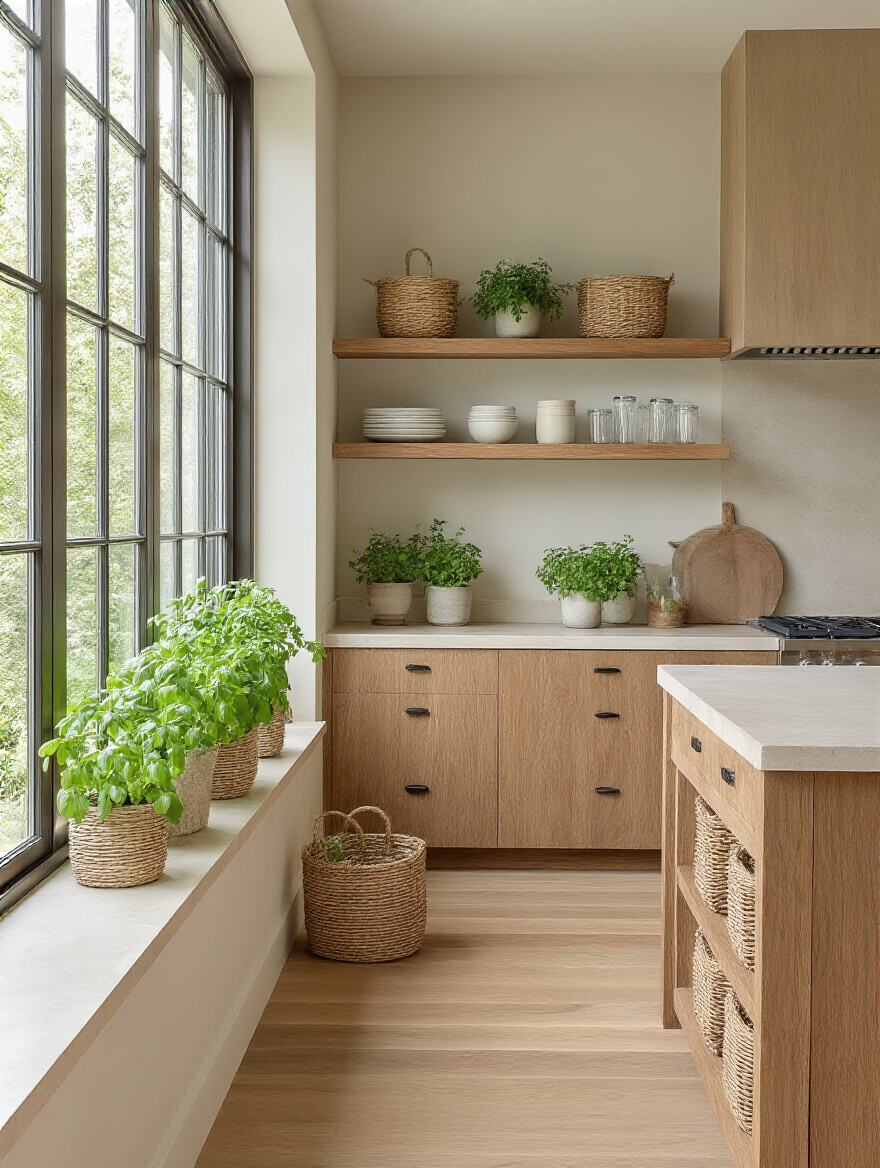
This doesn’t have to be complicated. A small pot of herbs on the windowsill. A beautiful wooden cutting board leaning against the backsplash. A bowl of lemons on the counter. A single branch in a simple vase on the island. These small touches of organic texture and color are essential for making a space feel human and inviting.
I once worked on a kitchen that was all sleek gray and white. It was stunning, but it felt a little like an operating room. The homeowner added a collection of small potted succulents on some floating shelves, and the entire room just sighed with relief. It was exactly the touch of warmth it needed. Don’t underestimate the power of a damn plant.
18. Incorporate Distinctive Backsplash Materials for Impact
If your cabinets and countertops are the quiet, supporting actors, the backsplash can be the star. It’s a fantastic opportunity to add texture, pattern, and personality in a focused, high-impact way. Instead of a standard subway tile, think a little bigger.
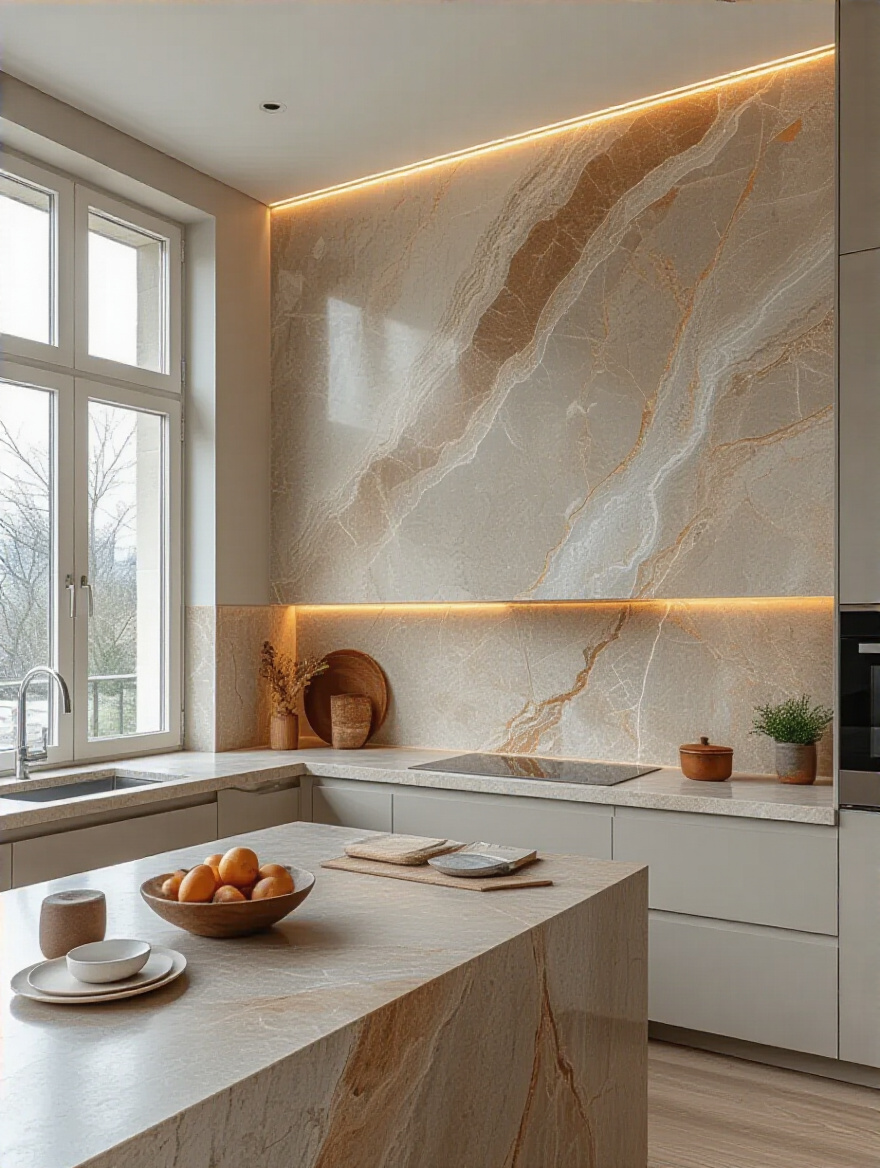
I love seeing clients use a single, continuous slab of the same material as their countertop for the backsplash. It’s a bold, seamless look that feels incredibly luxurious and is a breeze to clean—no grout lines at all. Another great option is handmade tile, like Zellige. The slight imperfections and variations in color give it a texture and depth that machine-made tile just can’t replicate. It adds a layer of history and craft to a modern space.
The BS to avoid is the “statement tile” that’s just a busy, loud pattern. More often than not, it will look dated in a few years. Instead, focus on a statement of materiality or texture. That has real staying power.
Functionality & Maintenance: Sustaining the Aesthetic
A beautiful kitchen that’s a pain to use or keep clean isn’t a success; it’s a failure. The final, crucial part of mastering the modern aesthetic is ensuring it works as beautifully as it looks, day in and day out.
19. Implement Smart Storage Solutions to Minimize Clutter
This is the secret weapon behind every impossibly clean-looking modern kitchen you see in magazines. It’s not that the people who live there don’t own stuff; it’s that their stuff is stored brilliantly. Smart storage isn’t about buying a bunch of plastic bins; it’s about designing the insides of your cabinets as thoughtfully as you design the outsides.
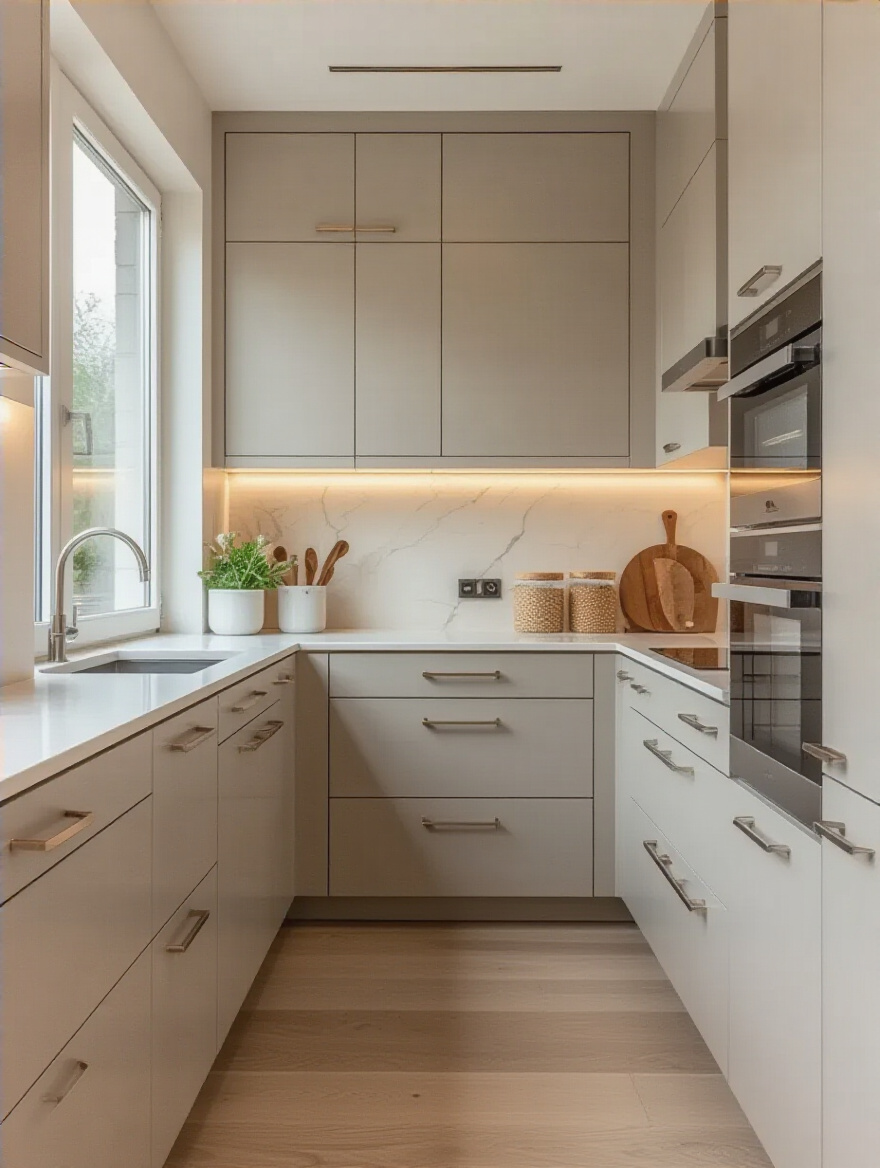
Think full-extension drawers instead of deep lower cabinets where things get lost in the back. Install vertical dividers for cookie sheets and cutting boards. A pull-out pantry can store an incredible amount of food in a narrow footprint. And my personal favorite, the “appliance garage,” a cabinet that sits on the countertop with a lift-up or retractable door to hide the toaster and blender.
I worked with a family whose old kitchen was a chaotic mess. In the new one, we designed a dedicated “breakfast station” cabinet with outlets inside for the coffee maker and toaster, plus drawers for mugs and bread. It completely streamlined their morning routine and kept the countertops clear. The best storage solves a specific, daily problem.
20. Utilize Integrated Smart Technology for Streamlined Control
Let’s be clear: I’m not talking about a refrigerator that texts you when you’re low on milk. That’s mostly a gimmick. I’m talking about smart technology that is either invisible or so seamless it genuinely makes your life easier. Think about a touchless faucet you can turn on with the back of your hand when you’re handling raw chicken. That’s smart.
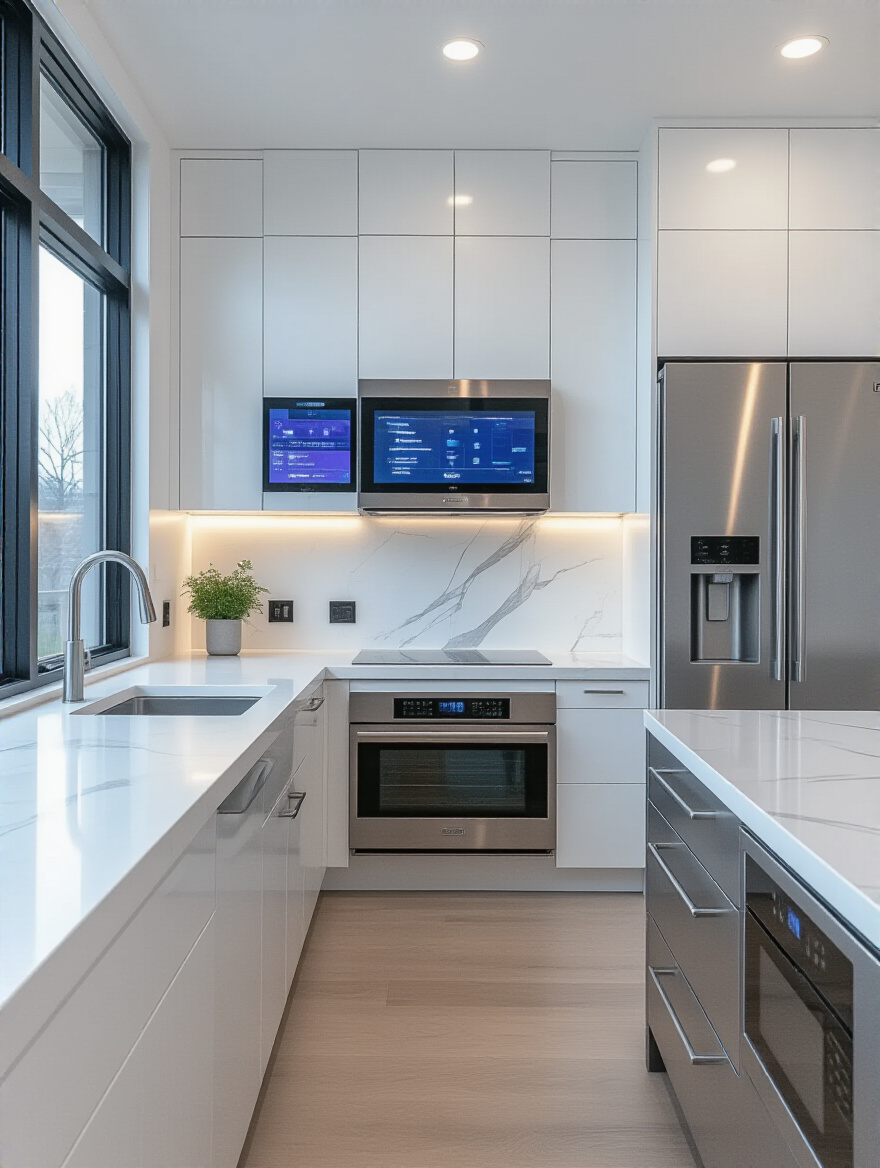
Smart lighting systems that let you create different “scenes” with the touch of a button or a voice command are incredibly useful. Under-cabinet lights that turn on automatically when you walk into the dark kitchen for a glass of water are a small luxury that you’ll appreciate every single night.
The key is to focus on technology that reduces friction and clutter. If it requires a complicated app and a 10-step process, it’s not making your life better. The best smart tech feels like magic—it just works, quietly and reliably in the background, making the kitchen more effortless to use.
21. Curate Strategic Decorative Objects for Visual Interest
Your kitchen shouldn’t be a museum, but it also shouldn’t be devoid of personality. Once the renovation is done, the final layer is adding a few strategic objects that make the space feel like yours. This isn’t about clutter; it’s about curation.
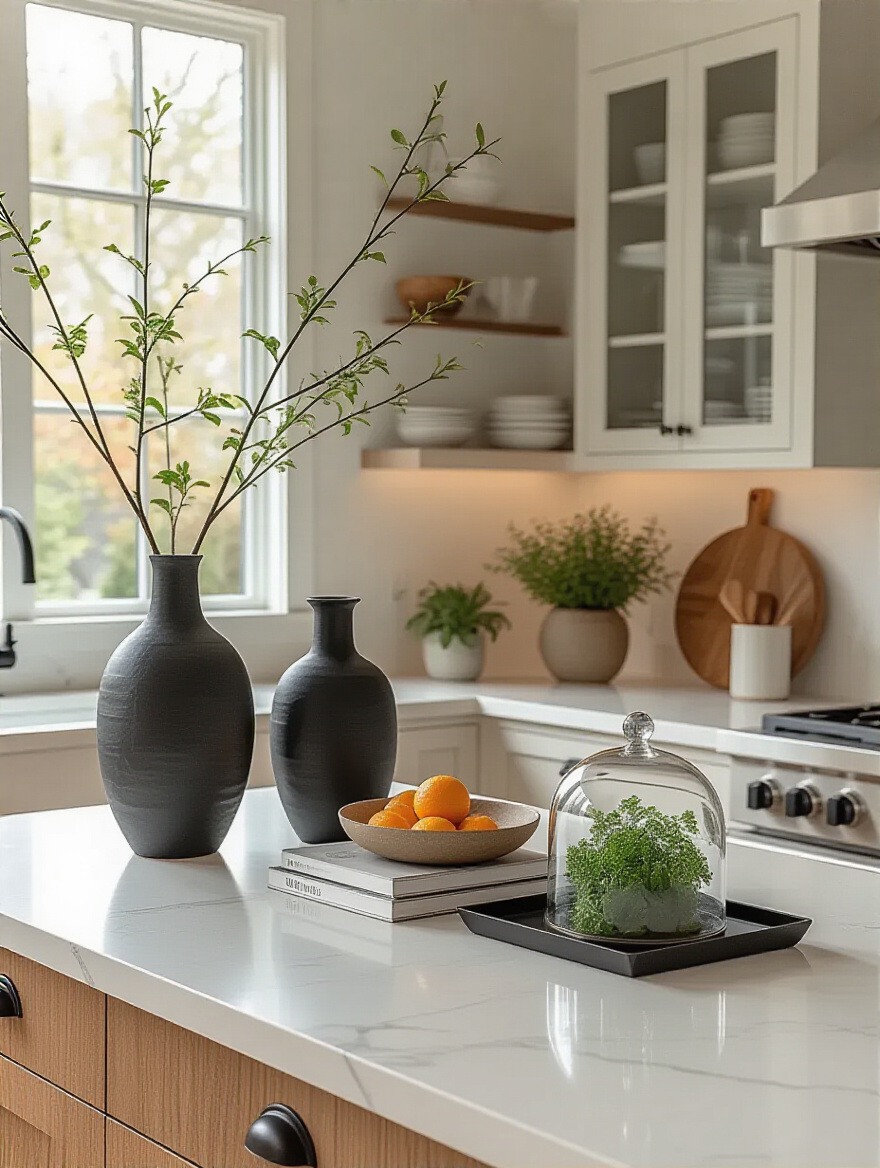
A beautiful piece of pottery you picked up on vacation. A single, striking piece of art on a bare wall. A vintage cookbook on a stand. The key is to choose just a few things that have meaning or beauty, and then give them plenty of space to breathe. Don’t line up a dozen little knick-knacks on your windowsill. One beautiful vase is more powerful than 20 cheap ones.
The shortcut here is to use a tray. Grouping a few smaller items—say, a salt cellar, a pepper grinder, and a small bottle of olive oil—on a simple tray makes them look like an intentional collection, not just random stuff on the counter. Plus, you can move it all as one unit when you need to clean.
22. Develop a Cleaning Routine to Preserve Pristine Surfaces
This is the least glamorous tip, but it’s the most important. A modern kitchen, with its clean surfaces and minimalist ethos, looks its best when it is spotlessly clean. Fingerprints on high-gloss cabinets, crumbs on a dark countertop, or water spots on a stainless steel appliance can undermine the entire aesthetic.

You don’t need to deep clean every day, but you do need a system. The most effective one I know is the “5-Minute Reset.” At the end of every day, take five minutes to clear the counters, wipe them down, put any stray items away, and wipe out the sink. That’s it.
It’s a tiny habit, but it’s transformative. It prevents the small messes from turning into big, overwhelming ones. It means you wake up every morning to a clean, calm kitchen, ready for the day. That simple routine is what will keep your beautiful new kitchen looking beautiful for years to come.
Conclusion
In the end, designing a great modern kitchen isn’t about following a rigid set of rules or chasing the latest trend. It’s a way of thinking. It’s about prioritizing quality over quantity, function over frills, and timelessness over fads. It’s about creating a space that is calm, efficient, and a true reflection of how you want to live.
Whether your home is a hundred years old or brand new, these principles hold true. By focusing on a solid foundation of light and space, investing in honest, durable materials, and paying attention to the small details that bring a space to life, you can create a kitchen that feels perfectly modern, yet will never go out of style.
